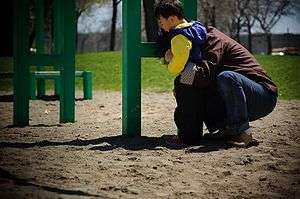Enuresis
Enuresis is a repeated inability to control urination.[1] Use of the term is usually limited to describing people old enough to be expected to exercise such control.[2] Involuntary urination is also known as urinary incontinence.[3] The term is from the Ancient Greek ἐνούρησις enoúrēsis.
| Enuresis | |
|---|---|
 | |
| A child may ignore the body's signal of a full bladder in order to engage in a joyous activity, such as playing on a playground. | |
| Specialty | Urology, pediatrics |
Signs and symptoms
Nocturnal enuresis usually presents with voiding of urine during sleep in a child in whom it is difficult to wake. It may be accompanied by bladder dysfunction during the day which is termed non-mono symptomatic enuresis.[4] Day time enuresis, also known as urinary incontinence, may also be accompanied by bladder dysfunction.
The symptoms of bladder dysfunction include:[4]
- Urge incontinence - the presence of an overwhelming urge to urinate, frequent urination, attempts to hold the urine and urinary tract infections.
- Voiding postponement - delaying urination in certain situations such as school
- Stress incontinence - incontinence that occurs in situations when increased intra-abdominal pressure occurs such as coughing.
- Giggling incontinence - incontinence that occurs when laughing.
Secondary incontinence usually occurs in the context of a new life event that is stressful such as abuse or parental divorce.[4]
Diagnosis
Clinical definition of enuresis is urinary incontinence beyond age of 4 years for daytime and beyond 6 years for nighttime, or loss of continence after three months of dryness.[5] Current DSM-IV-TR criteria:
- Repeated voiding of urine into bed or clothes (whether involuntary or intentional)
- Behavior must be clinically significant as manifested by either a frequency of twice a week for at least three consecutive months or the presence of clinically significant distress or impairment in social, academic (occupational), or other important areas of functioning.
- Chronological age is at least 5 years of age (or equivalent developmental level).
- The behavior is not due exclusively to the direct physiological effect of a substance (such as a diuretic) or a general medical condition (such as diabetes, spina bifida, a seizure disorder, etc.).
All these criteria must be met in order to diagnose an individual.
Classification
- Primary enuresis refers to children who have never been successfully trained to control urination.[6] This represents a fixation.
- Secondary enuresis refers to children who have been successfully trained and are continent for at least 6 months but revert to wetting in a response to some sort of stressful situation.[6] This represents a regression.
Types of enuresis include:
- Nocturnal enuresis (bedwetting) which is wetting that occurs in the night while asleep.[6][4]
- Diurnal enuresis which is wetting that occurs during the day while the child is awake.[6][4]
- Mixed enuresis - Includes a combination of nocturnal and diurnal type. Therefore, urine is passed during both waking and sleeping hours.
Treatment
Medications
Nighttime incontinence may be treated by increasing antidiuretic hormone levels. The hormone can be boosted by a synthetic version known as desmopressin, or DDAVP.[6] Desmopressin is approved for use by children. There is good short-term success rate; however, there is difficulty in keeping the bed dry after medication is stopped,[6].
History
Enuresis has been mentioned in Egyptian medical texts as early as 1550 BC.
See also
References
- "enuresis - Definition". Merriam-webster.com. Merriam-Webster. Archived from the original on 2009-04-25. Retrieved 2009-06-16.
- Enuresis at the US National Library of Medicine Medical Subject Headings (MeSH)
- "Managing Urinary Incontinence Archived 2012-06-30 at the Wayback Machine". National Prescribing Service
- von Gontard A. Enuresis. In Rey JM (ed), IACAPAP e-Textbook of Child and Adolescent Mental Health. Geneva: International Association for Child and Adolescent Psychiatry and Allied Professions 2012.
- Ghai, OP; Paul, Vinod; Bagga, Arvind (2009). Essential Pediatrics, 7th Edition. CBS Publishers & Distributors Pvt Ltd. pp. 22-41. ISBN 9788123917771.
- Chowdhury SH, Cozma AI, Chowdhury JH. Incontinence - Child. Essentials for the Canadian Medical Liscensing Exam: Review and Prep for MCCQE Part I. 2nd edition. Wolters Kluwer. Hong Kong. 2017.
External links
| Classification | |
|---|---|
| External resources |